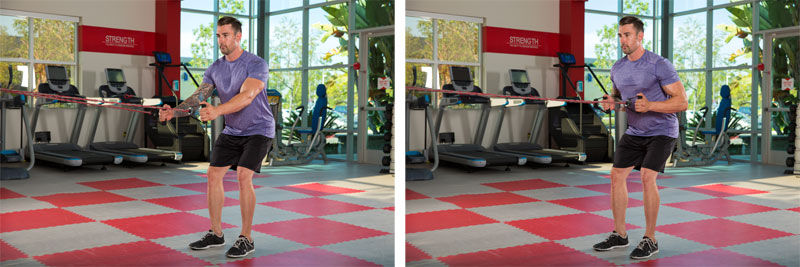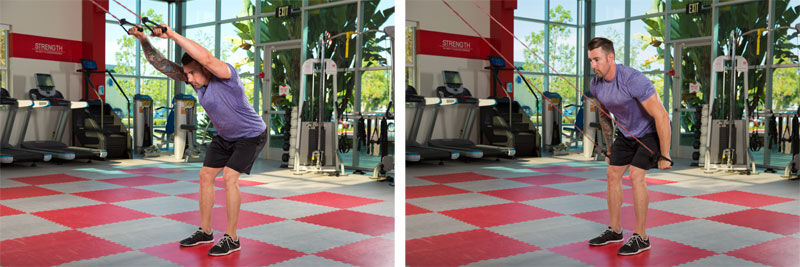If you watch sports on a regular basis, you may hear an announcer praise an athlete for being powerful. While strength is the physical ability to generate a high amount of muscle force, power is the ability to generate a high amount of force in a short period of time. It is important to include some power training in an exercise program to help improve the speed at which your muscles generate force.
According to the principle of specificity, muscles grow and adapt in response to the applied forces used during exercise. Exercise movements performed at a steady, slow tempo can help strengthen muscles, but those strong muscles may lack the ability to express that strength instantaneously. In other words, the muscles may be unable to generate the power necessary for many sports and common activities of daily living.
The benefits of power training include increased activation of the larger type-II (fast-twitch) fibers responsible for explosive muscle actions, reduced time for muscle force production, increased energy expenditure and increased lean muscle mass.
Many popular high-intensity exercise programs feature jumps, hops or skips to increase power output in lower-body muscles, but omit exercises for developing upper-body power. If you exercise for the purpose of improving your performance in sports such as tennis, softball, baseball, volleyball or Ultimate Frisbee, or if you want to improve your ability to perform daily tasks such as carrying a bag, caring for young children or gardening, it is important to perform exercises to improve the strength and power of the muscles of the upper back, shoulders, arms and hips. While the hips aren’t necessarily an upper-body muscle, optimal power for many upper-body movements—from throwing a ball to punching an opponent to picking up a young child—is derived from the ability of the hips to generate force, which is then transmitted and released through the shoulders and arms.
The following workout program features exercises to help develop upper-body power. To develop optimal levels of power, focus on only doing a limited number of repetitions—usually six or less. Trying to do too many reps of a power exercise can lead to fatigue, which greatly increases the risk of injury. In addition, allow for proper rest to ensure that the involved muscles replenish ATP (energy) and experience neural recovery. For power training, try to time the working set and follow a rest-to-work ratio of at least 5:1; for a set that takes 15 seconds to complete allow at least 75 seconds of rest. Do a complete dynamic warm-up to properly prepare your muscles before beginning the high-intensity exercises of the working sets.
Barbell High pull
Intensity: 50-75% 1RM
Reps: 2-6
Sets: 2-5
Rest Interval: 90 seconds to 3 minutes
Description: Stand with your feet hip-width apart as you tightly hold a barbell in front of your waist with your hands shoulder-width apart. Hinge your hips back while keeping your spine straight as you lower the bar to slightly above your knees. Explosively push your feet into the floor, rise up on your toes as you snap your hips forward and pull the bar straight up the front of your body. Keep your elbows out wide and allow the bar to travel up to chest height before allowing it to drop back down.
Benefits: This exercise teaches the hip and core power necessary to successfully perform other lifts such as the hang clean and push jerk, making it good warm-up movement. The force to move the bar is generated by the lower body, but the arms and shoulders control the path of motion. The high eccentric forces required to slow the bar down as it descends can help improve upper-body strength and power.
Barbell Hang Clean

Intensity: 50-75% 1RM
Reps: 2-6
Sets: 2-5
Rest Interval: 90 seconds to 3 minutes
Description: Stand with your feet hip-width apart as you tightly hold a barbell in front of your waist with your hands shoulder-width apart. Hinge your hips back while keeping your spine straight as you lower the bar to slightly above your knees. Explosively push your feet into the floor, rise up on your toes as you snap your hips forward and pull the bar straight up the front of your body. As the bar passes your navel, snap your elbows down by your rib cage and drop your hips into a squat so that you catch the bar on the front of your shoulders. Your palms will be facing the ceiling and your elbows will be pointed straight ahead. Stand all the way up. Lower the bar back to the starting position under control.
Benefits: This exercise strengthens the hips, back, shoulder, arm and core muscles. Forces generated by the legs and hips accelerate the bar, while the upper-body muscles work to decelerate motion of the bar and catch it on top of the shoulders. It also helps generate high levels of total-body power. While the hips generate upward momentum of the bar, it’s important to have the mobility to drop into a squat to get under the bar in order to catch it properly.
Barbell Push Jerk

Intensity: 50-75% 1RM
Reps: 2-5
Sets: 3-5
Rest Interval: 90 seconds to 3 minutes
Description: Grip the bar with your hands shoulder-width apart. Let the bar rest across the front of your shoulders so that your palms are facing the ceiling and your elbows are pointed straight ahead. Quickly dip your hips before explosively driving your feet into the ground to send the bar directly upwards overhead. As you drive the bar up, perform a little jump and land with your right foot forward and left leg behind (your feet should remain approximately hip-width apart). Tip: Allow your body to drop under the bar as it is moving upward. The bar should finish its upward trajectory as you keep your right hip in a flexed position. Press your right foot into the floor as you step forward with the left foot while holding the barbell overhead. Lower the bar to the shoulders and repeat.
Benefits: The strength to move the bar overhead is generated from the legs exploding into the ground. The shoulders and arms work to decelerate the bar at the top of the movement, creating the high eccentric forces necessary to increase muscle strength. This movement enhances activation of type II (fast twitch) muscle fibers and improves anaerobic efficiency, specifically the ATP-PC energy pathway. The focus of this exercise is to move the bar as fast as possible so it should be performed for only a few reps at a time with adequate rest between sets to allow neural recovery and ATP replenishment.
Band Pulls

Intensity: Medium resistance band
Reps: 2-5
Sets: 3-5
Rest Interval: 90 seconds to 2 minutes
Description: Attach a double-band to a solid anchor point and hold one handle in each hand. Sink back into your hips with your feet pressed firmly into the ground and your spine in a lengthened position. Maintain good body position and use both arms to pull the bands back as fast as possible, bringing the handles toward your waist as you keep a 90-degree bend in both elbows.
Benefits: This exercise helps develop explosive strength in the upper back and triceps muscles. Maintain a straight spine as you sink back into a partial hip hinge and keep your arms straight with hands facing each other.
Dumbbell Uppercuts

Intensity: 40-60% 1RM
Reps: 6-10
Sets: 3-5
Rest Interval: 90 seconds to 2 minutes
Description: Stand with your feet hip-width apart and hold one dumbbell in each hand so that your palms are facing up. Tuck in your elbows by each side and sink back into your hips. Press your left foot into the ground to rotate to your right (keep your right foot pressed firmly into the ground so that you rotate around your right hip). Keep your left elbow bent as you perform an uppercut with your left arm, bringing your left elbow to shoulder height. Lower your left arm and rotate back to center where you push your right foot into the ground to rotate around your left hip while swinging your right arm up in an uppercut. Alternate sides for desired number of repetitions. (Tip: The movement comes from your shoulder; your elbows should stay bent at 90 degrees throughout the duration of the exercise.)
Benefits: This movement integrates strength and power between the hips, core and shoulders. The hips generate the force to initiate the movement of the dumbbells. The shoulders and upper arms control the force required to control and decelerate the movement. The high eccentric forces (as the weight is lowered down) can help increase strength and power of the shoulders and upper arms.
Explosive Straight-arm Press-downs

Intensity: Medium band
Reps: 8-15 or for time
Sets: 3-5
Rest Interval: 1-3 minutes
Description: Attach a double-band to a solid anchor point above head height (a pull-up bar works well). Hold one handle in each hand with the palms facing the floor. Sink back into your hips with your feet pressed firmly into the ground and your spine in a lengthened position. Maintain good body position and use both arms to push the bands down as fast as possible, allowing your hands to move back behind your glutes as you press down. Tip: Instead of counting reps, set a timer and try to perform as may reps as possible in a specific amount of time.
Benefits: This movement provides specific conditioning to improve power output and anaerobic efficiency of the upper back and posterior shoulder muscles. It also improves type-II (fast-twitch) muscle fiber actions, and is an effective way to develop upper-body strength for older adults who may have limitations to perform certain exercises.




 by
by 









 by
by